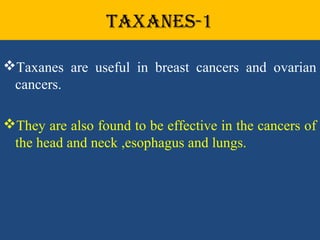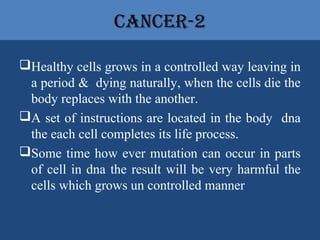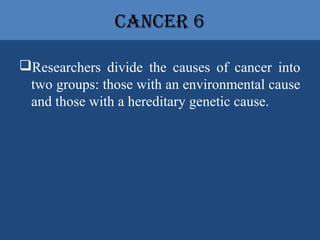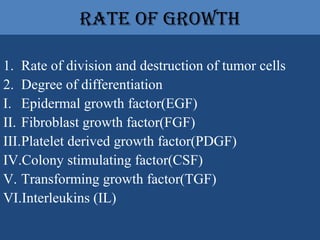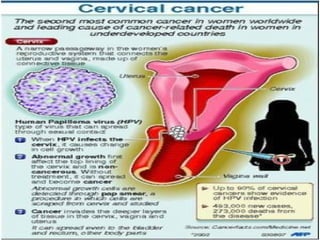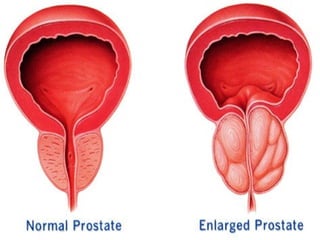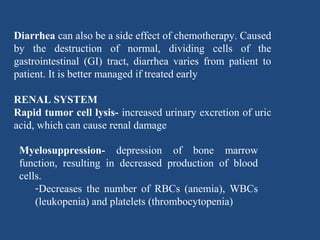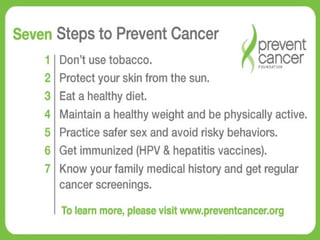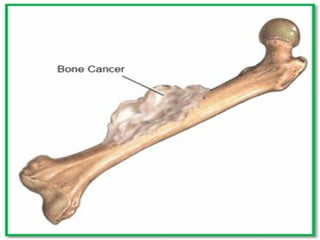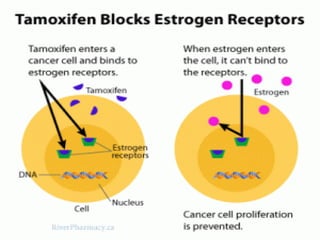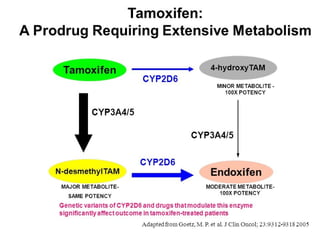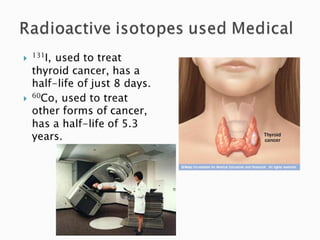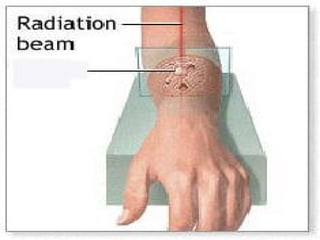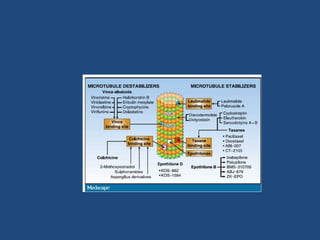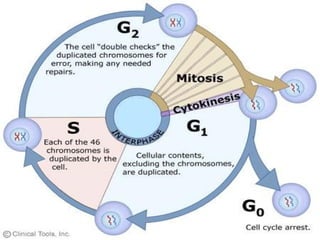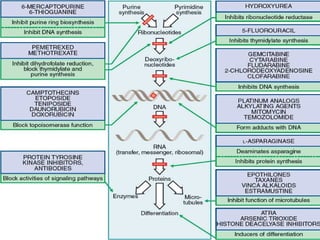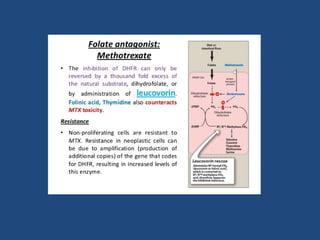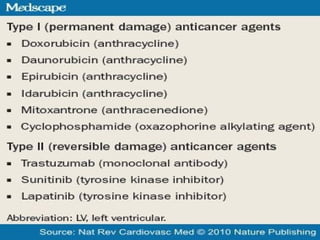Chemotherapy of cancer
- 1. Chemotherapy of malignanCy Balaji College of pharmaCy mr.B.ChaKrapani m.pharm aSSiStant profeSSor pharmaCology&CliniCalpharmaColgy Balaji College of pharmaCy phone no :+91-9618279507 anticancer@rediffmail.com anantapur.
- 3. 2.ANTIMETABOLITES -FOLATE ANTAGONIST: METHOTREXATE -PURINE ANTAGONIST: MERCAPTOPURINE, THIOGUANINE, PENTOSTAIN, FLUDARABIINE, CLADRIBINE. PYRAMIDINE ANTAGONIST: 5-FLUROURACIL, FLOXURIDINE, CYTARBINE, (CYTOSINE ARABINOSIDE) GEMCITABINE.
- 5. miSCellaneouS PROCARBAZINE MITOTANE L-ASPARAGINASE HYDROXYUREA CISPLATIN INTERFERON ALPHA IMATINIBS
- 6. SpeCifiC adverSe effeCtS of Some antiCanCer drugS DRUGS SPECIFICADVERSE EFFECTS OTHER PROMINENT ADVERSE EFFECTS CYCLOPHOSPHAMIDE CYSTITIS STOMATITIS BONE MARROW DEPRESSION,ALOPECIA,V OMITING,AMENORRHEA,T ERATOGENICITY BUSULFAN PULMONARY FIBROSIS STOMATITIS BONEMARROW DEPRESSION,ALOPECIA,V OMITING,AMENORRHEA,T ERATOGENICITY.
- 7. SpeCifiC adverSe effeCtS of Some antiCanCer drugS DRUGS SPECIFICADVERSE EFFECTS OTHER PROMINENT ADVERSE EFFECTS CISPLATIN OTOTOXICITY RENAL DYSFUNCTION BLEOMYCIN PULMONARY FIBROSIS,EDEMA OF HANDS. STOMATITIS,ALOPECIA. DAUNORUBICIN CARDIOTOXICITY,RED CLOURED URINE BONE MARROW DEPRESSION,ALOPECIA. DOXORUBICIN CARDIOTOXICITY BONE MARROW DEPRESSION,ALOPECIA. MITHRAMYCIN HEPATATOXICITY THROMBOCYTOPENIA
- 8. uSeS of alKylating agentS ALKYLATING AGENTS USES MECHLOROETHAMINE HODGKINS DISEASES CYCLOPHOSPHAMIDE LYMPHOMAS AND LEUKEMIAS IFOSFAMDE IMMUNOSUPPRESIVE AGENT CHLOROAMBUCIL CHRONIC LYMPHOCYTIC LEUKEMIA MELPHALAN MULTIPLE MYELOMA BUSULPHAN CHRONIC MYELOID LEUKEMIA CARMUSTIN MALIGNANT BRAIN TUMORS, MELANOMA,LYMPHOMAS
- 9. CampotheCinS Campothecin, analogs, topotecan and irinotecan cause breaks in DNA leading to cell death . Both are given intravenously. Toxicity is milder and includes diarrhea and bonemarrow suppression, nausea, weakness, and skinrash.
- 10. CampotheCinS-1 Irinotecan inhibits the enzyme acetylcholinestrase resulting in accumulation of acetylcholine causing excessive salivation ,abdominal cramps,miosis,bradycardia,and sweating which respond to treatment with atropine.
- 11. hormoneS and their antagoniStS GLUCOCORTICOIDS ANDROGENS ANTIANDROGENS ESTROGENS ANTIESTROGENS PROGESTINS AROMATASE INHIBITORS.
- 13. CanCer Cancer is one of the major causes of death. The treatment of cancers is still unsatisfactory due to certain characteristics of the cancer cells. Like capacity for uncontrolled proliferation, Invasiness Metastasis
- 14. Common adverSe effeCtS to antiCanCer drugS 1.BONE MARROW DEPRESSION 2.OTHER PROLIFERATING CELLS. 3.IMMEDIATE ADVERSE EFFECTS. 4.TERATOGENECITY 5.CARCINOGENECITY
- 15. impliCationS Correct dose should be determined and should be double checked before administration. Avoid direct contact of the anticancer drug with skin and mucosa during preparation of the formulation. Monitor urine output. Most anticancer drugs can cause vomiting .
- 16. Make sure antiemetics are given 30min before the administration of such anticancer drugs. Ensure that the patient is mentally prepared for hair loss with chemotherapy. Pregnant nurses should avoid handling anticancer drugs.
- 17. With repeated cycles, patients would be immunosuppresed ,so strict aseptic precautions are to be taken. Fever in immunosuppresed patient should be reported immediately. Take care to avoid extravasations of these drugs because most of the anticancer drugs are irritants.
- 18. taxaneS Paclitaxel was obtained from the bark of the western yew tree . It arrests cell division (Mitosis). Paclitaxel is given intravenously. It is metabolized in the liver. Adverse effects include: Myelosupression Myalgia Peripheral neuropathy Docetaxel is more potent and orally effective.
- 19. taxaneS-1 Taxanes are useful in breast cancers and ovarian cancers. They are also found to be effective in the cancers of the head and neck ,esophagus and lungs.
- 20. CanCer 1 A group of diseases characterized by abnormal growth of cells . To understand the effective of abnormal cells first u have to know the function of healthy cells. Each of us made up of millions of cells buliding blocks of body cells make up of tissue ,tissue makes up of organ.
- 21. CanCer-2 Healthy cells grows in a controlled way leaving in a period & dying naturally, when the cells die the body replaces with the another. A set of instructions are located in the body dna the each cell completes its life process. Some time how ever mutation can occur in parts of cell in dna the result will be very harmful the cells which grows un controlled manner
- 22. CanCer-3 The initial mutation can occur from with in the body penetrate in the body. External factors :chemicals ,tobacco, radiation, from the sun. What ever the cause of dna mutation once it occur can occurs cancer cells are often to began and divide very rapid rate this can lead to built of mass of cells known tumor.
- 23. CanCer -4 Some times tumors will be benign meaning Other tumors are malignant (or) cancerous actually they attract to blood ,because they need blood & nutrients & oxygen supply because the tumor has to grow. Cancer become more serious when the cells break away from malignant tumor & metastasis & spread through blood stream (or) lymphatic system , through distant organs.
- 24. CanCer -5 The lymphatic system is one of the body for the first defense against diseases it includes , bone marrow, spleen,thymus,lymphnodes & lymph vessels. Cancer can be curable but it is most dangerous second disease in the world.
- 25. CanCer 6 Researchers divide the causes of cancer into two groups: those with an environmental cause and those with a hereditary genetic cause.
- 26. neoplaSm The term neoplasia means new growth’ New growth produced is called neoplasm (or) tumor. How ever all new growths or not neoplasm. Since examples of new growth of tissues and cells also exist in the process of embryogenesis, regeneration and repair , hyper plasia and hormonal stimulation .
- 27. definition of neoplaSm 1 Mass of tissue formed as a result of abnormal , excessive , un coordinated autonomous and purposeless proliferation of cells. Neoplasm may be benign when they are slow – growing and localized with out causing much difficulty to the host or malignant when they proliferate rapidly , spread through out the body and may eventually cause death of the host
- 28. epidemiologiC faCtorS of CanCer A large number of pre disposing epidemiologic factors or co –factors Chronic non – neoplastic (pre-malignant) condition Role of hormones in cancer
- 29. pre diSpoSing faCtorS 1. Familial and genetic factors Retino Blastoma Familial polyposis coli Multiple endocrine neoplasia (MEN) Neuro fibromatosis Cancer of the breast Dna –chromosomal in stability syndrome
- 30. CharaCteriStiCS of tumorS 1. Rate of growth 2. Clinical and gross features 3. Microscopic features 4. Local invasion(direct speed) 5. Metastasis (distant speed)
- 31. rate of growth 1. Rate of division and destruction of tumor cells 2. Degree of differentiation I. Epidermal growth factor(EGF) II. Fibroblast growth factor(FGF) III.Platelet derived growth factor(PDGF) IV.Colony stimulating factor(CSF) V. Transforming growth factor(TGF) VI.Interleukins (IL)
- 32. CliniCal & groSS featureS The gross appearance Benign tumors Malignant tumors
- 33. environmental & Cultural faCtorS 1. Cigarette smoking 2. Alcohol abuse 3. Alcohol &tobacco together 4. Cancer of the cervix 5. Penile cancer 6. Betal nut cancer 7. Industrial & environmental substance 8. Certain constituents of the diet 9. Age 10.sex
- 34. diagnoSiS of CanCer Histological method Cytological method Histochemistry & cyto chemistry Immuno chemistry Electron microscopy Tumors makers (bio chemical assay) Modern aids in tumor diagnosis I. Flow cytometry II.Insitu hybridisation III.Molecular diagnostic technique Analysis of molecular cytogeneic abuse
- 35. Cancers are classified by the type of cell that the tumor resembles and is therefore presumed to be the origin of the tumor. These types include: Carcinoma: Cancer derived from epithelial cells. This group includes many of the most common cancers, including those of the breast, prostate, lung and colon. Sarcoma: Cancer derived from connective tissue, or mesenchymal cells. ClaSSifiCation of CanCer
- 36. ClaSSifiCation of CanCer 1 Lymphoma and leukemia: Cancer derived from hematopoietic (blood-forming) cells. Germ cell tumor: Cancer derived from pluripotent cells. In adults these are most often found in the testicle and ovary, but are more common in babies and young children. Blastoma: Cancer derived from immature "precursor" or embryonic tissue. These are also commonest in children
- 38. Cell CyCle
- 39. 6-12 h S G1 6-8 h G2 M 3-4 h 1 h Cell CyCle
- 40. Antineoplastic agents are used in an attempt to destroy tumor cells by interfering with cellular functions including replication. Chemotherapy is used primarily to treat systemic disease rather than localized lesions that are amenable to surgery or radiation.
- 41. To understand how chemotherapy works as a treatment, it is helpful to understand the normal life cycle of a cell in the body. All living tissue is composed of cells. Cells grow and reproduce to replace cells lost during injury or normal "wear and tear." The cell cycle is a series of steps that both normal cells and cancer cells go through in order to form new cells. worKing
- 42. g1 phaSe G1 Phase– This is the phase in which the cell spends almost all of its time. It is the normal phase of the cell. The cell is doing what ever that cell was designed to do. For example: a skin cell would function as a skin cell during G1 and a liver cell would function as a liver cell during G1.
- 43. S phaSe S phase – the s phase is the phase during which dna replication is occurring. Out of sight of most people’s ability to see, the dna is undergoing replication so, at the end of the s phase, there would be two complete sets of dna in the nucleus of that cell. In the s phase the cell has copied the contents of its nucleus
- 44. g2 phaSe G2 Phase- In this phase, the cell makes copies of the important organelles found in the cytoplasm. If a cell is going to divided, it needs enough mitochondria, (power plants) endoplasmic reticulum, (highways) and so on to support itself after cell division. If there are not enough mitochondria in one of the new cells, that cell will die and the main purpose of cell division, to make two cells out of one cell, will be for nothing. In G2 phase, the important organelles in the cytoplasm are copied to ensure that the two new cells will have enough organelles each to survive.
- 45. There are four parts to this phase; 1)PROPHASE, 2)METAPHASE, 3) ANAPHASE , 4) TELOPHASE. M Phase- This phase is the phase during which the nucleus divides into two nuclei. At the end of the M Phase, there will temporarily be a single cell with two nuclei.
- 46. prophaSe Prophase – Spindle fibers form, Chromosomes shorten, thicken and become visible (under a microscope) and the nuclear membrane begins to dissolve.
- 49. METAPHASE Spindle fibers move the chromosomes, which have their copies wrapped around themselves, to the middle of the nucleus and line them up.
- 51. ANAPHASE Spindle fibers shorten and pull the identical chromosomes away from each other to the opposite side of the nucleus.
- 53. TELOPHASE Spindle fibers dissolve, chromosomes lengthen out and become invisible again, nuclear membrane reforms around both sets of separated chromosomes.
- 55. CYTOKINESIS The cytoplasm divides leaving you with two identical cells, each with one nucleus.
- 61. TYPES Of CANCEr
- 63. HOdgKIN'S-dISEASE-SYMPTOMS CYCLOPHOSPHAMIdE MECHLOrOETHAMINE Hodgkin's disease a disease with rubbery enlargement of lymph nodes and enlargement of spleen
- 64. HOdgKIN'S dISEASE-SYMPTOMS drugS ArE uSEd : CYCLOPHOSPHAMIdE MECHLOrOETHAMINE Hodgkin's disease a disease with rubbery enlargement of lymph nodes and enlargement of spleen.
- 65. HOdgKINS-dISEASE-SYMPTOMS Hodgkin's disease a disease with rubbery enlargement of lymph nodes and enlargement of spleen.
- 68. LuNg CANCEr Methotrexate –lung cancer Mechanism of action :Inhibits di hydrofolate reduction blocks TMP and Purine synthesis
- 69. LuNg CANCEr Methotrexate –lung cancer Mechanism of action :Inhibits di hydrofolate reduction blocks TMP and Purine synthesis
- 70. Methotrexate –lung cancer Mechanism of action :Inhibits di hydrofolate reduction blocks TMP and Purine synthesis
- 86. WILMS TuMOr: Malignant mixed tumor of the kidney seen in children below fifth year
- 87. NEOPLASM : Any abnormal new growth, tumor benignant, not malignant
- 88. CErvICAL CANCEr CISPLATIN –CErvICAL CANCEr
- 89. Second years II-I semester Cancer of Buccal mucosa invading extra-oral tissues following tobacco quid habit
- 94. Dr Suwas Darvekar Cancer of Tongue following tobacco consumption
- 95. Dr Suwas Darvekar Alveolar cancer after tobacco quid habit
- 99. Chemotherapy is a common treatment for a variety of cancers. It has proven to be safe and effective. An understanding of this treatment helps patients better recognize and tolerate side effects, if they occur
- 100. Assess fluid and electrolyte status (Anorexia, nausea & vomiting, altered taste and diarrhea put patient at risk) Modifying risk for infection and bleeding (suppression of the bone marrow and immune system) Administering Chemotherapy patient is observed for extravasation (particularly of vesicant agents, which may produce necrosis if deposited in subcutaneous tissues Protect caregivers
- 101. Diarrhea can also be a side effect of chemotherapy. Caused by the destruction of normal, dividing cells of the gastrointestinal (GI) tract, diarrhea varies from patient to patient. It is better managed if treated early RENAL SYSTEM Rapid tumor cell lysis- increased urinary excretion of uric acid, which can cause renal damage Myelosuppression- depression of bone marrow function, resulting in decreased production of blood cells. -Decreases the number of RBCs (anemia), WBCs (leukopenia) and platelets (thrombocytopenia)
- 102. Nausea & Vomiting- most common side effects of chemotherapy and may persist for as long as 24-48 hrs. after its administration. Mucositis – inflammation of the mucosal lining
- 103. It can cause irritation which can eventually lead to inflammation of the mouth, a condition known as stomatitis . A stinging sensation in the throat may develop and lead to dysphagia (difficulty in swallowing). Management: Good oral hygiene gastroiNtestiNaL systeM
- 104. What are the side effeCts of CheMotherapy? SKIN Alopecia Hair loss occurs because chemotherapy can sometimes damage healthy cells. It is so common because hair follicle cells multiply very quickly like cancer cells and chemotherapy drugs have difficulty in discerning the difference.
- 105. sequeNCe of treatMeNts: Adjuvant therapy: Therapy given after surgery to reduce the likelihood of the cancer returning. Neo-adjuvant therapy: Therapy given before surgery to shrink the tumor, allowing the surgery to be more successful. Concurrent therapy: When 2 or more therapies are given together, such as chemotherapy and radiation.
- 106. Orally (by mouth, in pill form) Intravenously (IV, through a vein, either as a short infusion or continuously for one or more days) As an injection or needle Directly into a body cavity (i.e.: the bladder, abdominal cavity) Intra-arterially (in special cases, such as limb perfusion treatment for melanoma) hoW is CheMotherapy giveN?
- 107. REPRODUCTIVE SYSTEM Take effective contraceptive precautions when having chemotherapy, as the chemotherapy drugs might harm the baby if pregnancy occurs. In some women, chemotherapy brings on anIn some women, chemotherapy brings on an earlyearly menopausemenopause. This may cause symptoms such as dryness. This may cause symptoms such as dryness of the vagina and a decreased interest in sex.of the vagina and a decreased interest in sex.
- 108. NEUROLOGIC SYSTEM •Peripheral neuropathies •Loss of deep tendon reflexes •Paralytic ileus MISCELLANEOUS •Fatigue •Alopecia
- 110. Rand 50.3
Editor's Notes
- #70: Tmp thymidine mono phosphote



















